Energy and Enthusiasm Reign at Chicago Collective Men’s Show
- Oops!Something went wrong.Please try again later.
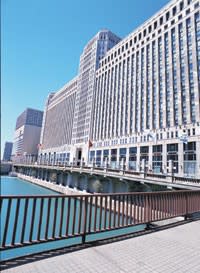
CHICAGO — Many men’s specialty stores are coming off of the best year in their history thanks to a post-pandemic jump in sales. And while they’re not experiencing the same unparalleled upsurge in 2023 as they did in 2021 and 2022, the majority are still seeing upticks in business — albeit at more-conservative levels — and they’re fine with that.
Tailored clothing still leads the way for many stores as guys hit their local merchants to update their wardrobes for events and the hybrid work environment. But updated sportswear continues to be strong as well for more-casual occasions.
More from WWD
Retailers at the Las Vegas Trade Shows Juggle the Ups and Downs of the Economy
George Kolasa, Fashion Communications Veteran and Cancer Fighter, Dies at 57
With that as the backdrop, it was no surprise that the energy and attitude at the Chicago Collective show was decidedly upbeat. The floor, which was jam-packed with an overflow group of both vendors and retailers, felt like a throwback to old times. There were lots of hugs and backslapping in the aisles at the Chicago Merchandise Mart as manufacturers and their customers caught up on the latest fashion trends and industry gossip.
Bruce Schedler, vice president of the Chicago Collective, used every square inch of available space for the fair, which has evolved into the must-attend men’s show for independents and larger stores from across the country. Attendance was up more than 30 percent over last year and the retailers were “the right buyers,” he said. “There’s a real throwback vibe. People tell me they look forward to being here.”
In February, they’ll be able to spend more time at the show — which is at capacity with more than 400 vendors and a long waiting list — since the event will be expanded to four days from three. “Our intent is to go to 1 [o’clock] on the last day so retailers have at least three full days to shop,” he said.
One of the largest contingents of exhibitors this time was from Italy, which brought 62 brands through the Italian Trade Agency. Like the show itself, the organization also has a waiting list of brands hoping to secure a spot in the show, according to Paola Guida, deputy trade commissioner for the ITA. “I want more space,” she said, adding that more than 80 Italian companies would like to exhibit. “This show is overwhelming,” she said. “It’s more crowded than ever and that’s a sign that it’s the only trade show in the men’s sector. It’s a destination now — it does a super job between business and friendship, socializing and partnerships. Everyone has fun and does business.”
This will be Guida’s last show as she is transitioning out of the U.S. and will now represent the ITA in Bangkok. At the ITA’s Monday night cocktail party, Schedler and the attendees paid her a fond farewell and thanked her for her long-standing support of the show and her promotion of Italy’s fashion artisans.
Guida was not the only one who characterized the show as essential — that was the sentiment of many retailers as well.
Ken Giddon, president of New York-based Rothmans, said: “This show is amazing. The team has put together a menswear show you can’t miss. It’s the most user friendly, the hotels are close and you don’t have to walk 17 miles to find everything. It’s nice to see the industry fired up and there’s a lot of creativity and new lines here.”
He said he was at the show primarily for sportswear and singled out Rails, Faherty, Johnnie-O, Les Deux, Jack Victor and Borgo as standouts along with Johnston & Murphy’s JM collection of footwear.
Next month, his son Will, who works at the company, will be opening a new department at the Union Square flagship called Rothmans Next, targeted to a younger customer. “There will be breakthrough lines not featured in the main store,” he said. “It’ll be more of a laboratory so we’re also working on that here.”
Giddon said his overall business continues to be good, which is a pleasant surprise. “Most stores are coming off a record year and we’re coming back to more-sustainable levels, but we haven’t seen the downturn we had anticipated,” he said. “We had a good strong [spring] season and didn’t go off-price.”
He said much of the business continues to be event-driven for weddings and parties and “not a lot of guys are saying they need suits for work,” but sport coats continue to be a leader as a wardrobe refresher.
David Rubenstein, of Rubenstein’s in New Orleans, said his business is benefiting from the return of tourism in his home town as well as locals who are not holding back on spending. “There’s so much money in the upper market,” he said, adding that suits and sport coats are among the most popular categories. Custom suits are also gaining fans, especially young people who are enjoying the opportunity to create their own distinct looks.
In Chicago, he was checking out the European brands as well as pieces featuring unusual fabrics and finishes to attract shoppers searching for something new. And unless there’s a significant, unexpected event, Rubenstein is expecting business to continue to be robust this fall and holiday. “I see things staying good for a while,” he said.
Craig DeLongy of the seven-unit John Craig chain in Florida, was similarly upbeat. “Two years ago we were up 95 percent, last year we were up 45 percent and this year we’re up a couple of percentage points and we’re very happy with that.”
He said the suit business has been driving sales and he recently added some high-end brands such as Kiton to fulfill the demand. “But there’s no category we’re not doing well with,” he added. The only issue is that he’s slightly over-inventoried, but he’s expecting that to resolve later this year if sales continue on the same path.
At the show, he was searching for colorful wovens, knits and sport coats as well as new sneaker lines such as Rubiosa from Italy. “We’re going to narrow down our classification vendors to get back on track with inventory,” he said.
Keith Kinkade of Kinkade’s in Ridgeland, Mississippi, said his sales are running up some 18 percent for the year on top of last year, which was his best ever. Sales are being driven by polo shirts by his number-one vendor, Gen Teal, as well as Citizens of Humanity, 7 Diamonds, TaylorRed suits, Empire Clothing, David Donahue, Johnnie-O, FX Fusion, JC Richards ties and JM shoes.
Looking forward, he believes business will continue to be good. “The industry and economists think there are pockets of opportunity with people moving from malls to specialty stores,” he said. “So as long as we provide personal experiences and are welcoming to customers, we’ll do fine. If you become lackadaisical, your sales will shift, but as long as you enhance their experience, you have them for life.”
Hal Lansky, of Lansky’s in Memphis, said his business continues to be good and he’s just hoping “the other shoe doesn’t drop. We’ve been in business over 50 years and we thought we were going to go out of business in 2020, but 2021 and ‘22 were the best years we ever had. I never saw a swing like that.”
“We’re moving from where we were to where we want to be,” added Benjamin Belton of Benjamin’s in Morganton, North Carolina.
At Lansky’s, customers are buying shoes, Robert Graham shirts, suits and sport coats as they move beyond the activewear they wore during the pandemic. “It’s time to dress up and move on,” he said.
But the comfort and technical properties men got used to in their athleisure wardrobes continue to impact other categories.
“Comfort and technical details are infiltrating menswear and there’s no looking back,” said Andrew Berg, president of Robert Graham. He added that while there are some headwinds that could impact sales later this year, companies that are strategic and inspire to keep customers engaged will come out on top.
Belton said he’s seen a lot of pent-up demand for pieces that “integrate” activewear elements in sport coats and other categories. At the Chicago show, he was shopping for tailored clothing as well as sportswear as he sought to fill his store with merchandise that ticked those boxes.
“Customer sentiment is good and we think fall and holiday will be great.”
One vendor seeing the impact of integrating more active elements into traditional classifications is Peerless Clothing, the country’s leading tailored clothing maker. Many of the brands produced by the company offer technical attributes to appeal to today’s customer.
At the show, Peerless was seeing a lot of interest from specialty stores shopping for updated suits and sport coats from Hart Schaffner Marx, TaylorRed and other brands.
Peerless’s largest labels continue to be Tommy Hilfiger and Calvin Klein, along with Michael Kors brand, which sell mainly at department stores.
Overall, while business has leveled off a bit from its peak, sales remain strong. “Core basics are always important and fashion sport coats are phenomenal,” said Dan Orwig, president of Peerless, adding that soft shoulders, patterns, colors, double-breasteds and peak lapels were among the most popular choices for specialty stores.
Tailored clothing, including formalwear, has been a standout performer for Rush Wilson’s in Greenville, South Carolina. Rush Wilson, the second-generation owner of the company, was walking the show with his son Jay who is playing a more active role in the company.
“Our business is good, we’re very fortunate to be in a growing community,” Rush Wilson said. Thanks to men who lost or gained weight during the pandemic and an active social calendar, it has led to strong sales, particularly for tuxedos.
At the show, they were shopping for clothing at David Donahue, Samuelsohn and Jack Victor as well as neckwear from Robert Jensen and sport shirts from Alan Payne.
Looking ahead, he was optimistic that business will continue on the same path. Pointing to all the corporations that call Greenville home such as BMW and Michelin, he believes demand will remain high.
“We’ve been on fire and we think fall and holiday will continue to be good,” he said.
Here are some standout brands from the Chicago Collective show:
Brand: Polo Ralph Lauren
Designer: Ralph Lauren
Backstory: The Polo names dates back to 1968, one year after the Bronx-born designer created his first neckties. A full menswear collection was offered the next year and Lauren drew from his love of sports to come up with the name for the nascent line, which offered a white flannel suit and dress shirts in addition to ties. The line took off quickly and two years later, Bloomingdale’s opened the first-ever shop for a designer line under the Polo by Ralph Lauren name. Polo moved into womenswear in 1971 and introduced the first polo shirt in 1972 in a rainbow of colors. Although the company has expanded significantly since then with luxury suit lines (Purple Label), sports-related offerings (RLX), a rugged Western-inspired line (Double RL) , home, retail stores and restaurants, Polo remains a mainstay of the company.
Key pieces: In advance of next year’s Olympics, where Ralph Lauren is an official outfitter, the spring collection revolves around France and is separated into different pillars. The first, Saint-Germain, offers a refined palette centered around navy, cream and white in a wide variety of knitwear, wovens, sweaters, tailored clothing and dress trousers. Key looks here include linen blazers, garment-dyed oxfords paired with striped Ts and cotton twill trousers, classic cashmere cable sweaters and five-pocket or drawstring waistband pants.
A second capsule is called American in Paris, and offers up a more preppy point of view with tweed sport coats in cotton and linen, classic oxford and rugby shirts, madras jackets and an array of the brand’s signature mesh polo shirts in a wide assortment of colors. The Polo Bear is featured on a variety of pieces, such as sweaters and a baseball hat. A beach-oriented capsule tied to the Cote d’Azur consisted of linen sport coats in royal blue, paisley polos and linen trousers, short-sleeved seersucker shirts in stripes and florals, washed oxfords, lightweight maritime shirts and chore jackets. The final grouping centered around denim and included everything from jeans and denim jackets to cargo shorts with frayed bottoms and military-inspired Army pants.
Retail prices: The polo shirts retail from $110 to $138, sport shirts for $125 to $168, cotton cable sweaters for $200, cashmere cable sweaters for $498 and sport coats for $498 to $998.
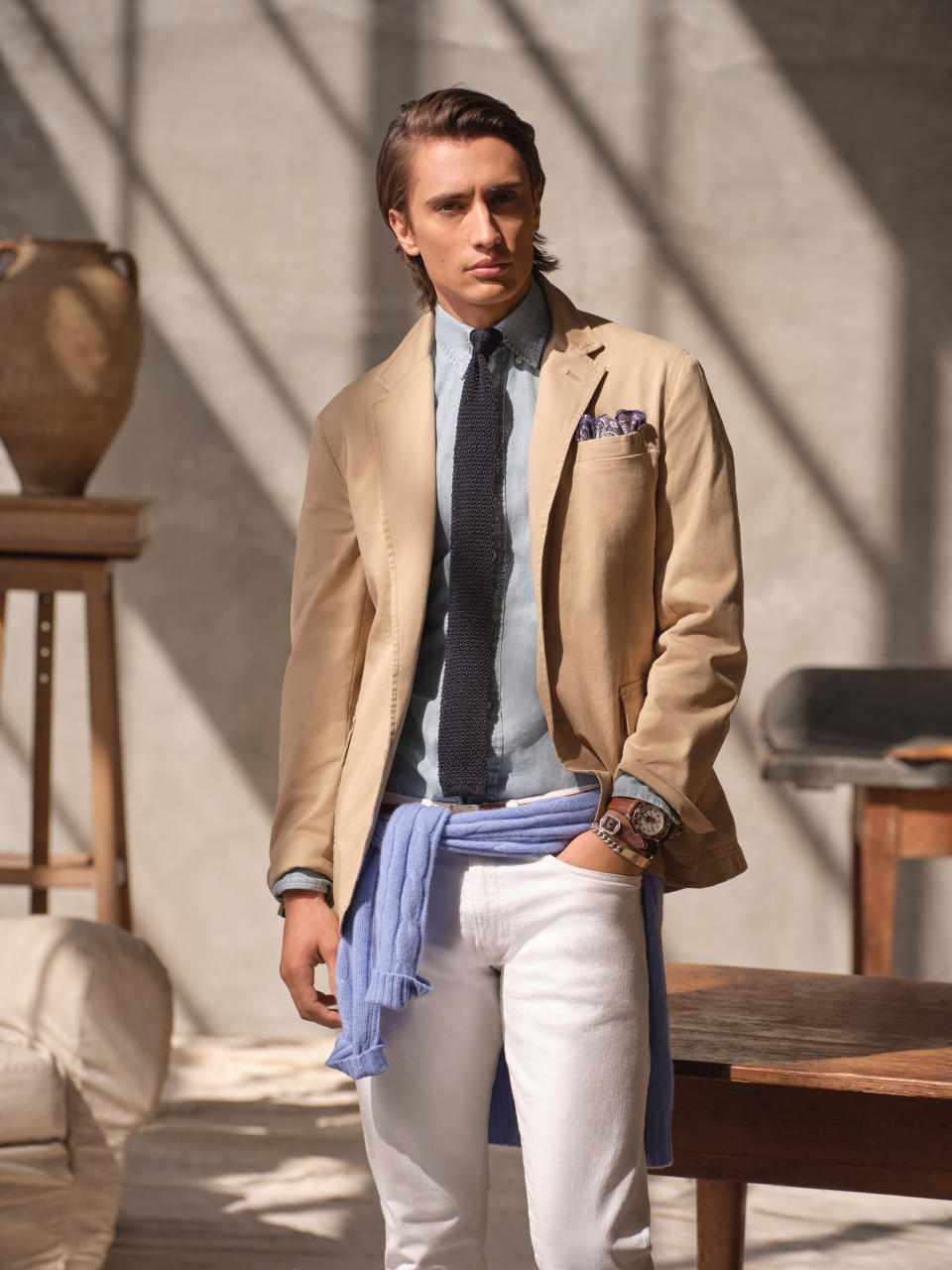
Brand: Hart Schaffner Marx
Backstory: The brand was founded in Chicago in 1872 when brothers Harry and Max Hart opened a small men’s clothing store on State Street. In 1879, their brothers-in-law, Levi Abt and Marcus Marx, joined the business, followed by a cousin, Joseph Schaffner. Fast forward to today, and the company, which had fallen on hard times, was acquired out of bankruptcy by Authentic Brands Group in 2012. And in 2018, the license for its men’s tailored clothing was awarded to Peerless Clothing.
Key pieces: The brand is still an “American heritage classic brand” anchored in suits and sold in better department and specialty stores, according to Dan Orwig, president of Peerless. The line is produced in Peerless’s factory in Montreal and offers both suits and sport coats. The silhouette in both has been updated to feature a softer shoulder and wider lapel — style markers that customers are responding to today. In addition to traditional menswear colors such as navy, tan and gray, the line — particularly within its sport coat offerings — features bold plaids and a palette that includes some fashion colors. The collection also features seasonal knits to complement the tailored clothing as well as a made-to-measure offering, which is currently doing quite well, according to Orwig. To support the made-to-measure part of the line, HSM has introduced a custom app where customers can log on in a store and customize their outfit. “There’s a romance and a heritage to made-to-measure boxes,” he said, “but this is the next evolution.”
Retail prices: Off-the-rack suits average $695 to $895; sport coats are $795 to $995, and the made-to-measure line ranges from $1,000 to $1,800.
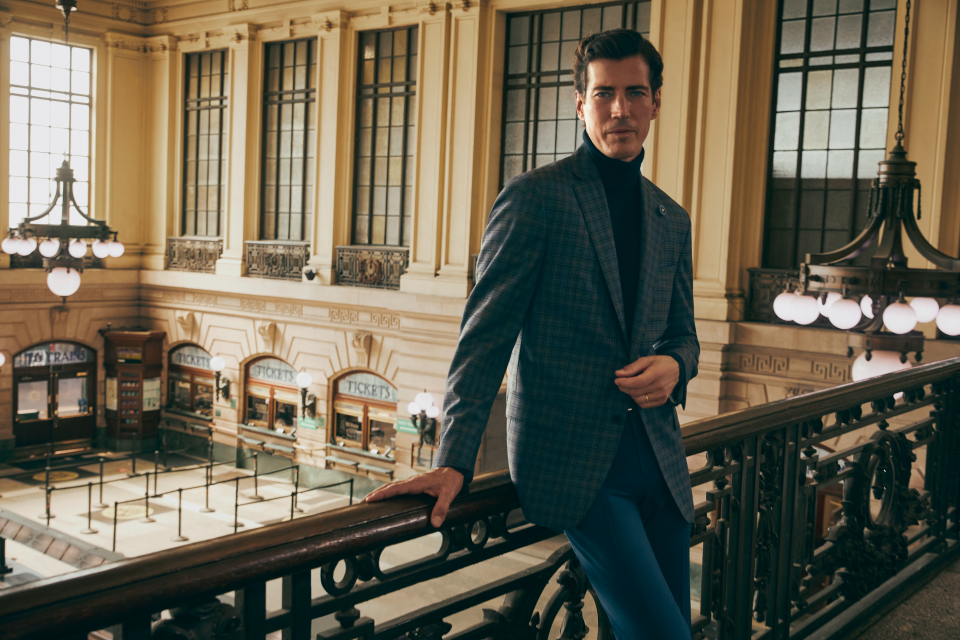
Brand: Robert Talbott
Designer: Nick Picchione
Backstory: The brand was founded by Robert and Audrey Talbott who left the East Coast with their son Robb in 1950 and moved to Carmel, California, where they started a business based on Audrey Talbott’s skill creating handcrafted silk neckwear. The company expanded into furnishings, men’s made-to-measure tailored clothing, knitwear, sportswear, leathers and womenswear. Robert Talbott died in 1986 and Audrey ran the business until her death in 2004 when it was left to Robb. The company passed through several hands until being purchased by Newtimes Brands, a 60-year-old privately owned supply-chain management firm based in Hong Kong, in 2021. Spring marks its official relaunch in the U.S. market with an updated men’s collection.
Key pieces: The line is manufactured in Europe but sports an American sensibility and specs. The cut, which was formerly oversize, is now modern and slim, but not skinny, with a focus on craftsmanship and fine fabrics, or what Picchione calls “elevated luxury.” In addition to a wide assortment of dress shirts, a hallmark of the brand, it also offers a range of sport shirts. One key look is a one-piece California collar shirt — “old Hollywood style,” as he described it — cut from a single piece of fabric with a roll that keeps its shape under a blazer. Short sleeves and long sleeves in stripes and checks as well as fine pinpoint washed styles that elevate the traditional oxford are also offered in silhouettes that can be worn tucked or untucked. There are 100 percent cotton pique polos with handpicked hems, fine-gauge knits, and in bottoms, garment-dyed chinos and five-pocket pants complement the shirts.
Retail prices: Knits range from $125 for a core T to $175 for a short-sleeve mesh. Sport shirts are $195 to $265, high-end shirts are $375 to $450 and a track jacket is $350. Bottoms range from $295 to $325.
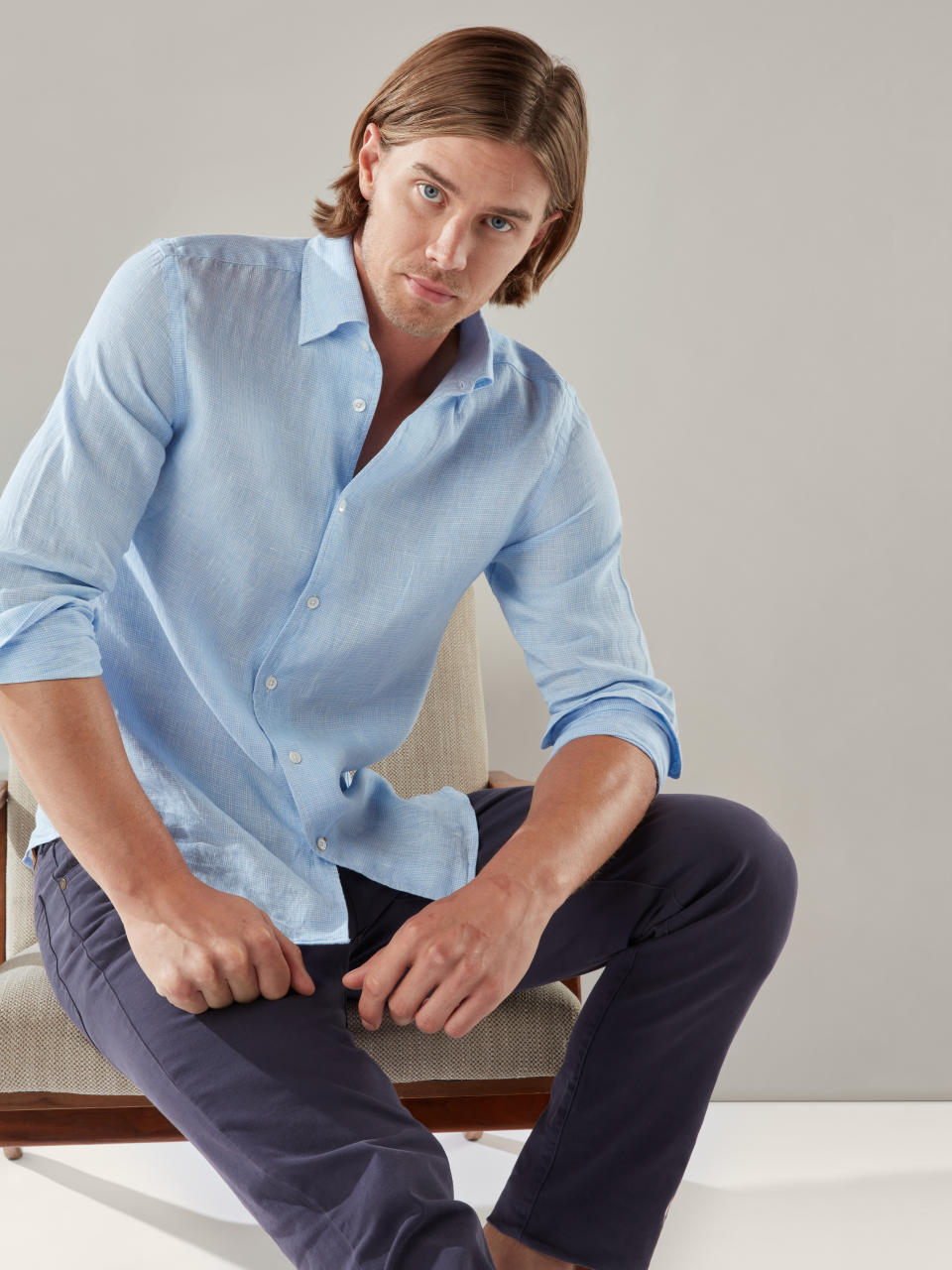
Brand: American Vintage
Backstory: The 20-year-old family-run business founded by Michael Azoulay is based in Marseille, France, and operates 160 stores in Europe as well as 40 shop-in-shops. It is known for its American lifestyle-based men’s, women’s and childrenswear with a streetwear-infused twist. Although it is well established internationally, it has turned its sights on the U.S. recently with an eye toward wholesaling as well as opening its own stores. Currently, it operates a small shop in SoHo but plans to open a larger store there and has signed leases in California, in Malibu as well as in South Coast Plaza in Costa Mesa, with five units planned within the next 12 months.
Key pieces: The brand, which is represented by Unison Brands Agency of New York in the States, was showing pre-spring at the show. Corduroy overshirts; drop-shoulder oversize Ts in a variety of finishes including slubs; fleece outerwear; a zip-up peacoat; natural undyed jeans; sweatshirts, and an oversize chore jacket were key pieces in the men’s assortment.
Retail prices: T-shirts retail for $60 to $75; sweaters are $170 to $190; denim is just over $100, and outerwear retails for $180 to $265.
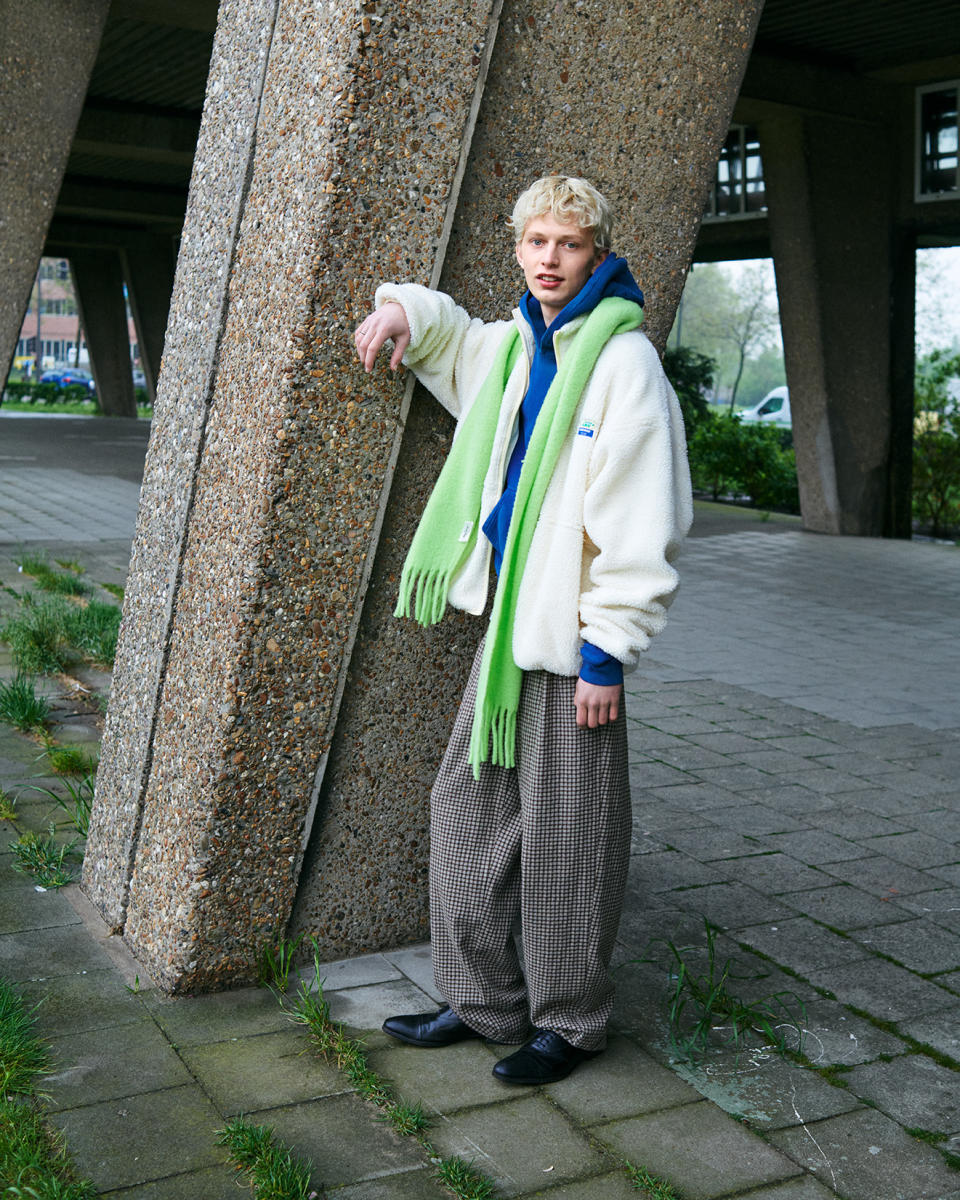
Brand: The Normal Brand
Designer: Jimmy Sansone
Backstory: The family-owned business got its start with Jimmy Sansone, who was frustrated with his work as an investment banker as well as the choices of menswear he found in the market — the options were either too high-fashion or too preppy. So even though he had no experience in the apparel industry, he set out to create a “normal” shirt for normal guys. He talked several of his brothers — he has nine siblings — into joining him on the journey, and today, the company offers a wide array of men’s and women’s basics that are comfortable, durable and versatile. It also operates eight stores with three more on tap for this year.
Key pieces: The spring collection is called Camp Normal and is inspired by the nostalgia of an American summer with vintage prints and graphics such as sun-baked neutrals, classic blues and vintage tones. Among the offerings are a canvas overshirt, pintuck joggers, cargo shorts, an expedition shirt, waffle knit polos, washed jeans, varsity sweatshirts, chambray button-ups and a cotton popover in a railroad stripe.
Retail prices: Knits retail for $40 to $60; wovens from $88 to $98, bottoms retail below $100 and outerwear is $158 to $168.
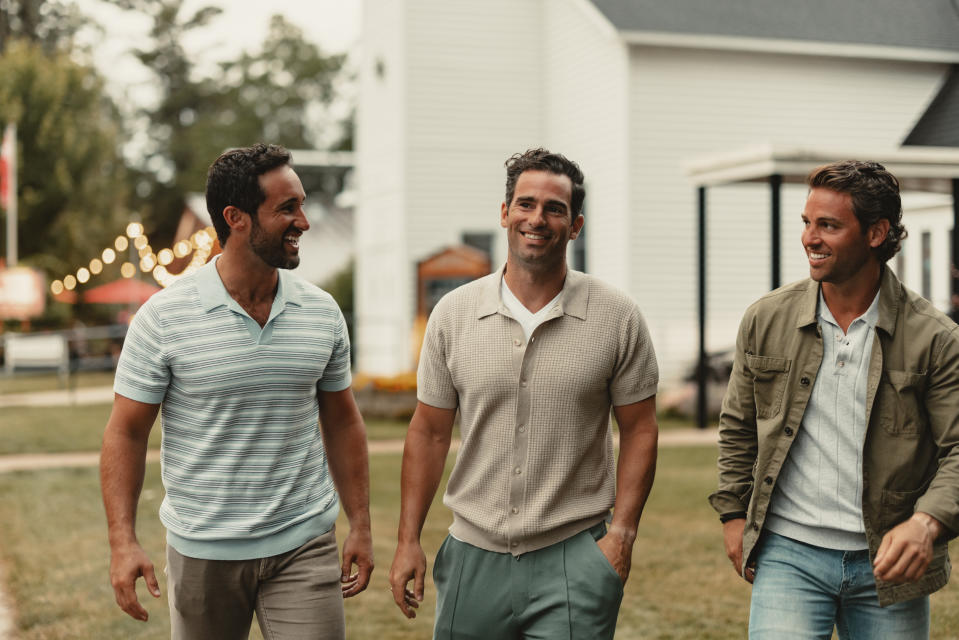
Brand: Original Madras Trading Company
Designer: Nicholas Benitz
Backstory: The Original Madras Trading Company is a third-generation family business operating out of New York City and Chennai, India. The brand, which is now run by Prasan Shah, was originally established by Shah’s grandfather upon his arrival to the United States from Chennai in the early ’70s with a storied trunk full of madras prints. The brand began by supplying madras check and Indian textiles to some of the biggest names in American fashion. Madras check is a pure cotton, yarn dyed plain weave cloth with a minimum two-color irregular pattern, and most importantly, woven in Madras with pure Indian cotton. All woven by hand, the Original Madras Trading Company operates out of the same building it has been located in for generations in New York’s Garment District, and offers an assortment that ranges from shirts (short and long sleeve) and Cuban or camp-collar style shirts to short jackets, pajama sets, robes and accessories such as beach mats, bandanas and bucket hats. The line is carried at Bergdorf Goodman, Neiman Marcus, David Wood and Mr Porter, among others.
Key pieces: Classic buttoned-down, long-sleeved, madras check shirt with a single pocket and a yellow gusset, which indicated that this is all hand-woven, as well as traditional American two-button madras unstructured blazers with lined sleeves, and hand-loomed denim pants (a first for the brand) were among the offerings.
Retail prices: Shirts range from $155-$185 and blazers go up to $265.
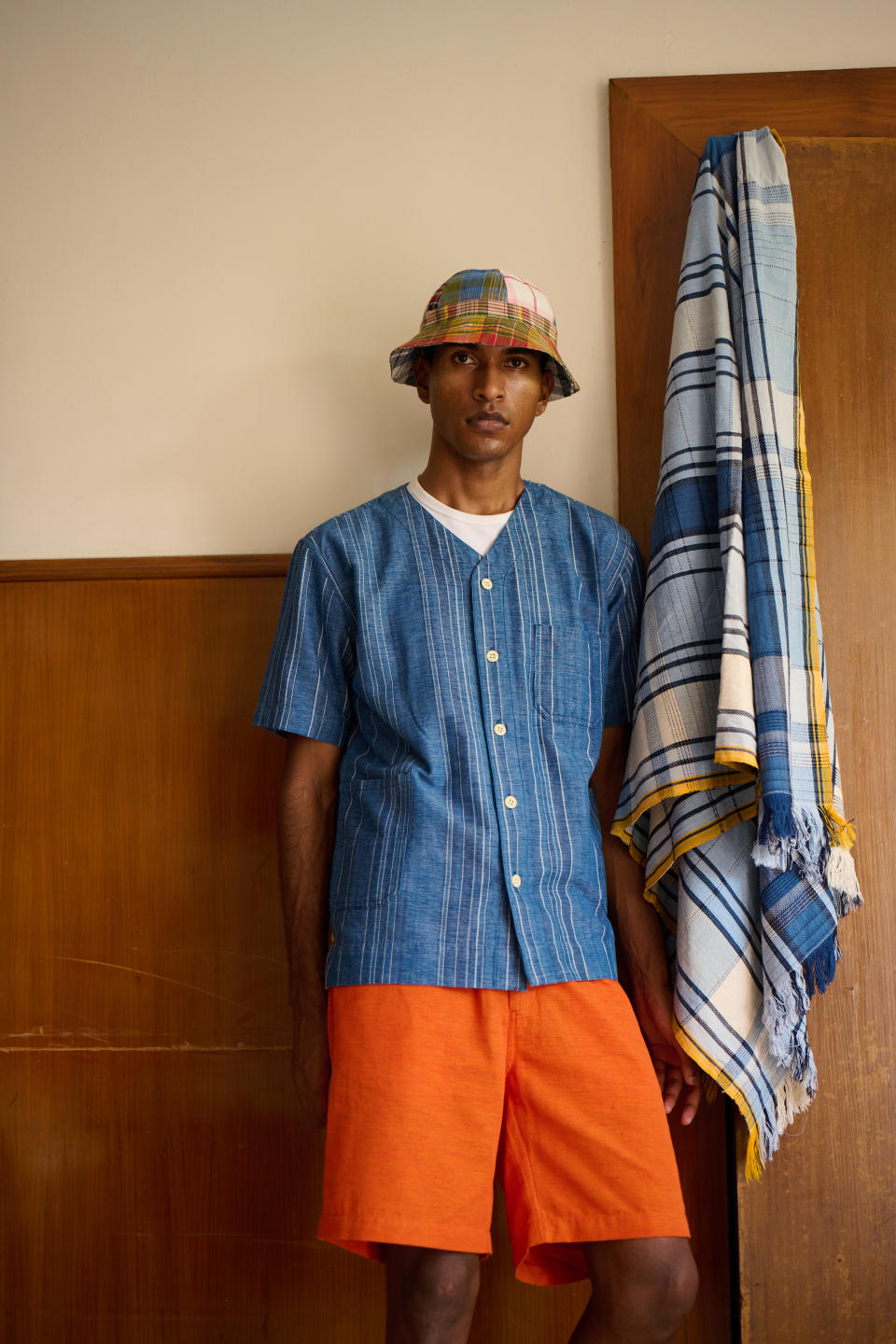
Brand: Lamano Artisans
Backstory: Based in Umbria, Italy, in the city of Assisi — which is often referred to as the cashmere district — Lamano Artisans was born with a passion for cashmere and craftsmanship. The brand was created five years ago and this marked the first time it presented at the Chicago collective. The Lamano Artisans name, which translates directly to “The Hand,” specializes in knitwear and knit outerwear with unique compositions derived from multifilament cashmere yarns, which are particularly strong and soft. The brand assortment ranges from cardigans and knit polos to T-shirts, in materials such as extra-fine merino wool, Giza cotton, silk and linen blends on gauge 18 and 21, creating pieces that are luxurious to the touch in wearable proportions.
Key pieces: The brand’s best seller is an 18-gauge crewneck cashmere 246 sweater, a piece that offers an extremely soft hand, and the brand also offers a cotton polo and short-sleeved crewneck T-shirt in Sea Island cotton, a material from the Caribbean islands that is rare and available in small quantities. There are also cable knit polos and Ts and knitted outerwear jackets in a Milano stitch in Loro Piana merino wools.
Retail prices: Knitwear ranges from $800-$1,000 with some of the outerwear pieces reaching up to $3,000.
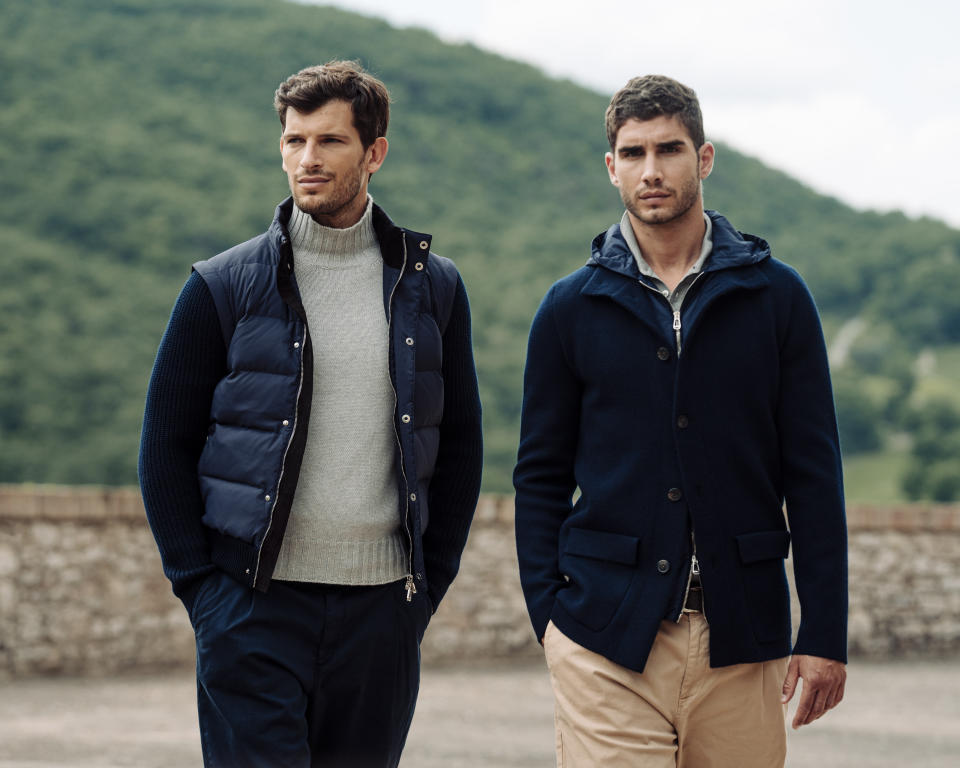
Brand: FTC Cashmere
Designer: Jana Knezovic-Grau
Backstory: Founded in 2003 by two cashmere lovers, Andreas and Jutta Knezovic, FTC Cashmere is a Swiss family business that has established itself as a knitwear specialist in the premium segment. The brand, whose initials stand for “Fair Trade Cashmere,” specializes in high-quality cashmere knits for men and women with a strong focus on sustainability. The raw material originates from inner Mongolia, where the Knezovic family has built up a network of cashmere farms with a goat population estimated at around 20,000, as well as a combing, spinning and dyeing plant. In addition to the 100 percent cashmere knits that are Oeko-tex certified, the brand offers a special material blend of SeaCell cashmere, composed of seaweed, in which FTC currently holds the worldwide exclusive rights to blend skin-friendly SeaCell algae fibers with cashmere. The proprietary blend is also said to offer health benefits to the wearer’s skin, releasing all of its minerals that the seaweed has collected. One of the brand’s current initiatives includes switching from shipping products in plastic poly bags to FSC-certified paper bags. Recently, the brand was nominated for the Green Business Award in Switzerland for its upcycling project, Up-Knit, in which all leftover yarns are fashioned into one-of-a-kind pieces, the most recent iteration being a cardigan model.
Key pieces: For spring, the men’s assortment focuses on color and textures, with pieces such as pastel crewneck sweaters (some in striped versions), degrade cable knit sweaters, and knit polo shirts with open structures that create striping effects. A standout was a knitted multicolor button-down overshirt with irregular stripes, made from the brand’s Up-Knit program.
Retail prices: Prices start at $349 for the 100 percent cashmere pieces, $279 for the organic cotton and cashmere blend sweaters, and $199 for the organic striped SeaCell cashmere pieces.
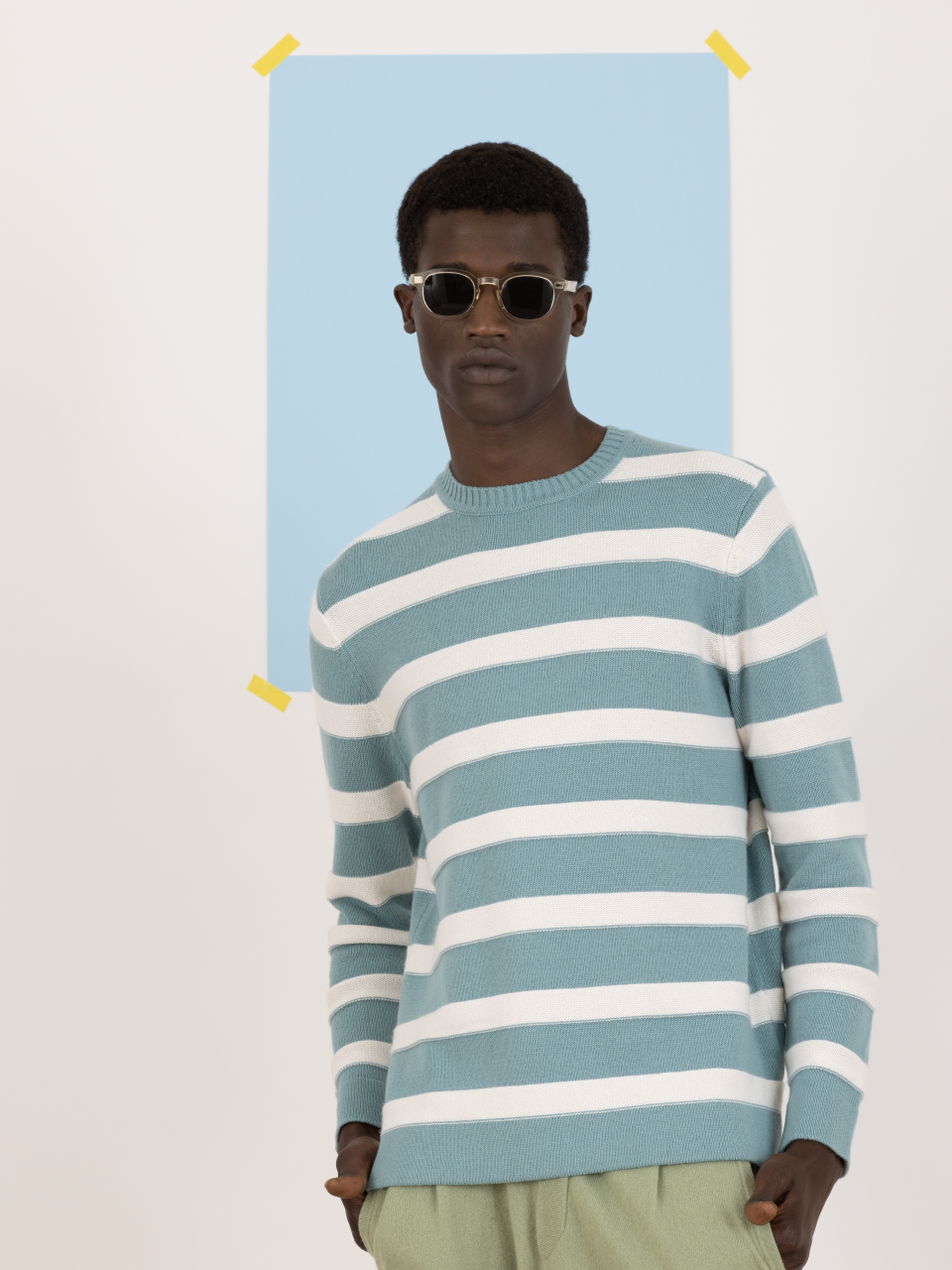
Brand: Teddy Vonranson
Designer: Teddy von Ranson
Backstory: A newcomer to the Chicago Collective, Canadian born-and-raised designer Teddy von Ranson has made his mark with his emerging namesake label, creating a sensibility that combines European flair with East/West Coast elements that range from surf, ski, skate and street influences. Von Ranson’s American sensibility stems from his post at Ralph Lauren where he worked for 15 years as well as the Frye Group, where he served as creative director, garnering him the spotlight as one of American menswear’s most exciting talents. His irreverent approach to fashion is shown in his intuitive ability to layer technical and fashion pieces for unexpected pairings to create the effortless cool West Coast sentiment with East Coast discernment that has advanced his story of the modern American man. Recently, Peter Gryson came on board as chief executive officer to handle the business end of the brand that sells at Neiman Marcus, Saks Fifth Avenue and Ron Herman to name a few.
Key pieces: For his spring lineup, the French Riviera was the source for von Ranson’s approach, as evidenced by the proportions of his garments and the use of French and modern workwear details infused with his own signature details. Von Ranson has found inspiration via painterly prints in his previous collections, and this season they range among artists such as Picasso, Matisse and abstract surrealists, which showed up in jacquard double-breasted topcoats and overshirts as well as an assortment of shirts. Key pieces included a white denim pant with workwear details and a slightly flared leg; denim cabin coats; wardrobe essentials such as pull-on drawstring cargo shorts in a technical twill; striped suits with a boxy silhouette, wide-striped oversized workwear shirts, and open crochet polos (which have been a strong seller for the brand in previous seasons). Other standout pieces included a jacquard double-breasted topcoat and zip-front overshirt in an abstract painterly print.
Retail prices: Prices for the new collection range from $595 for the carpenter pants, $325 for cargo shorts, $425 for the crochet camp shirts and $595 for the oversized shirts to $1,650 for the jacquard coat.
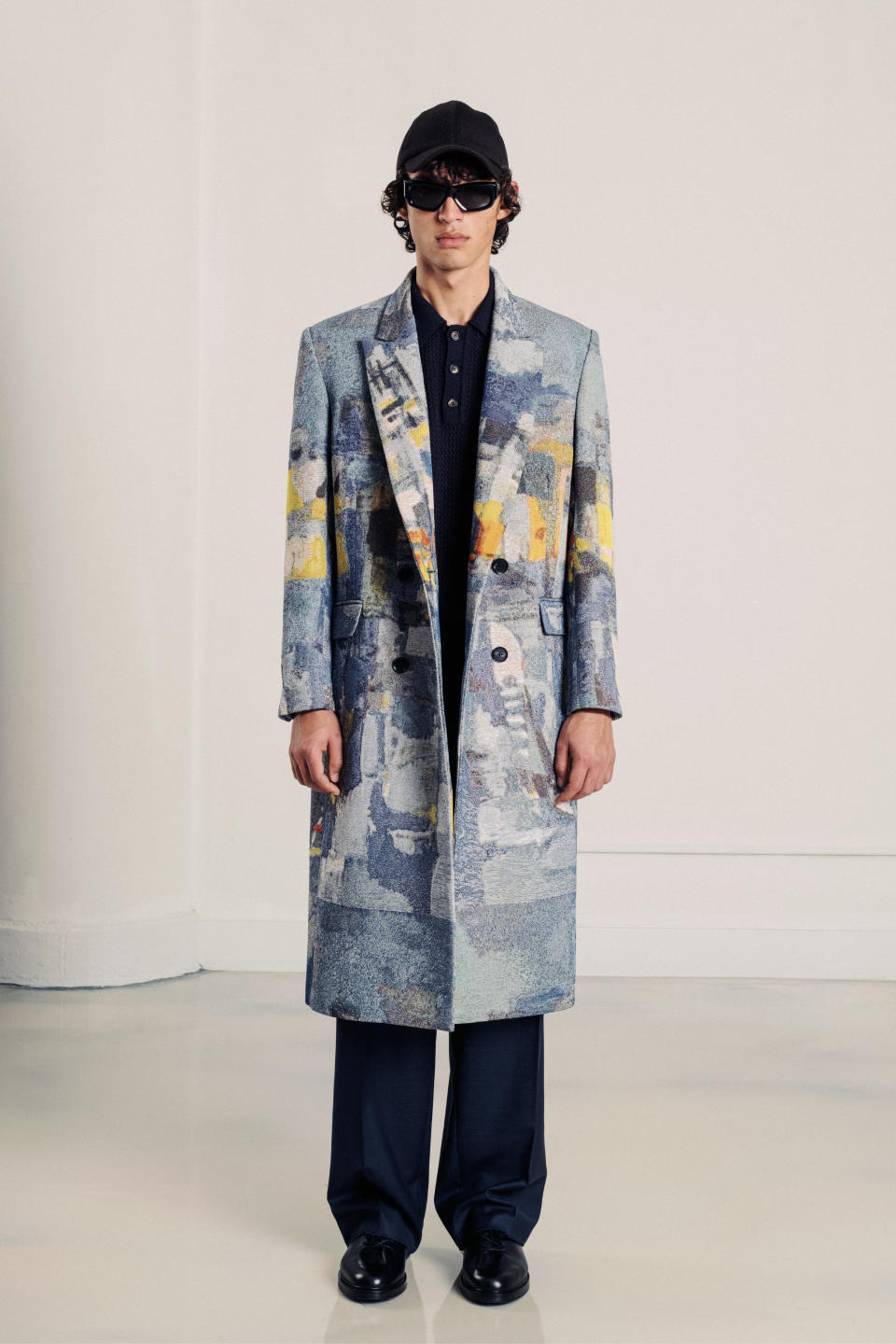
Best of WWD

